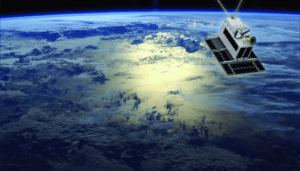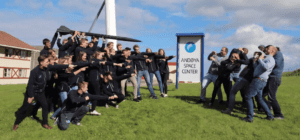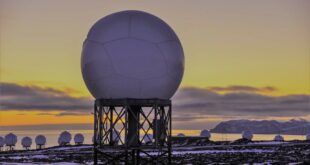by Mari Eldholm

Norway may not be as famous for its space efforts as its oil and gas sector, but that might be about to change. The Nordic nation has in the past year initiated and moved forward on several ambitious projects and is in the process of revamping the national ecosystem to promote a strong space economy.
Restructuring the Norwegian Economy: From Oil to Orbit
There is a national understanding that the Norwegian oil and gas-adventure is approaching its final chapters. Thus, one of the most prominent questions discussed in Norwegian politics is: What will Norway do after oil? In response, the government has initiated policies and plans to diversify the Norwegian economy, with a focus on promoting knowledge-driven and high-tech industries, which can promote sustainable development and green and blue growth. While there is no plan to dissolve the oil industry just yet, the climate and recent oil crises have made it obvious that it has become urgent to transform the Norwegian economy to make it more resilient, sustainable and future oriented.
Against this backdrop, the new Norwegian space ambition is being shaped. The space industry aligns well with the government’s goals and desired characteristics for the future Norwegian economy, and is also understood as an enabler for growth and innovation in other sectors. While nobody expects that the space industry alone will replace the enormous value creation generated by the oil industry, it will be an important part of the solution to a complex puzzle.
Legal and Policy Developments: A New National Space Strategy, Defence Plan and Space Law
Norway has been a space nation since the 1960s, but a new space age is dawning. A new national space strategy was adopted in June 2020, identifying four key goals: promoting a strong and profitable space industry, ensuring national user-needs, promoting space security and good global space governance. The 84-page document is a clear development of the national space ambition, and in the coming months the national apparatus will work on bringing it to life by identifying concrete actions to reach the goals.
In October 2020, a new national defence plan was introduced to parliament, which identifies a growing reliance on space in the defence domain. Subsequently, the plan sets forward goals to ensure the armed forces space needs. There is a specific focus on maritime surveillance from space, satellite communication in the Arctic and Space Situational Awareness. In addition, the National Defence Research Institute has initiated several small satellite projects and are collaborating with Norwegian and international companies to quickly develop national space capabilities relevant for military users.

Norway has one of the oldest national space laws in the world. The law from 1969 has only three paragraphs, simply stating that if you want to launch something from Norway into outer space, you must apply for a licence. No details provided.
Earlier this year an expert group delivered its recommendations for an updated space law, which would ensure Norway’s compliance with international obligations but also promote a strong space industry and regulate the numerous new activities being planned. The expert group’s recommendations have since been made available for public consultation, and a first draft of the space law is expected to be presented to Parliament for approval in 2021.
International Cooperation: The Cornerstone of the Norwegian Space Efforts
The cornerstone of the Norwegian space ambition has always been, and will continue to be, international cooperation. At the ESA Ministerial in November 2019 Norway reconfirmed its commitment to ESA, participating in most programmes and investing a record amount in space exploration and Earth observation.
In 2020 Norway also reconfirmed its ambition to continue to be part of HorizonEurope and the EU space program, which includes Copernicus, Galileo, EGNOS, GOVSATCOM and SSA. As a long-term contributor, partner, and user – Norway and the Norwegian space industry will continue to take part and offer its contribution to the European space efforts.
The Norwegian Government Teams Up with The Space Industry to Save Tropical Forests

The Norwegian government has long been at the forefront of using space-based data for reaching political objectives. But 2020 brought a notable new development, where the Norwegian government teamed up with partners in the space industry to solve a critical environmental issue.
In September it was announced that Norway’s Ministry of Climate and Environment entered into a contract worth up to NOK 400 million (approx. USD 43 million) with KSAT and its partners Airbus and Planet, to provide high-resolution satellite data of the tropics in order to support efforts to stop the destruction of the world’s rainforests. Through Norway’s International Climate & Forests Initiative, the high-resolution, analysis-ready mosaics of the world’s tropics will be free and available for anyone to use. This is a momentous step towards greater transparency and ensuring tools which will revolutionise the worlds efforts to combat deforestation and climate change.
Norway’s New Flagship Projects: A European Spaceport and Arctic Broadband Satellites
Over the years, the Norwegian government has initiated several flagship projects in cooperation with industry which have developed into commercially successful businesses. Examples include Telenor Satellite, which today is a leader in satellite communication and broadband services, and KSAT – a global leader in ground station and satellite services. Recently the government has initiated two new flagship projects.
Funding for the Andoya Spaceport has been allocated, and the development process has started with an aim to facilitate for up to 30 launches a year when the spaceport reaches full operational capability. The project is on track to conduct a launch in 2022 in partnership with the German micro-launcher company Rocket Factory Augsburg, but it is also planning to accommodate other launchers. The unique geographical location in the far north offers large ocean areas with little aviation traffic and easy access to polar orbits. At Andoya there is a deep-sea port, a military grade airport, and military grade infrastructure for testing and flight telemetry readily available. In addition, Andoya has 60+ years of experience and has launched over 1300 sounding rockets.
The other flagship project is the HEO-project being developed by Space Norway. At this moment there is virtually no broadband access in the Arctic, a problem the HEO-satellite constellation will solve. When launched in late 2022, it will provide satellite-based broadband in the whole Arctic (from 65 degrees north) for civilian users, as well as the Norwegian military and its allies. This will greatly enhance safety and security for all actors conducting activities in the northernmost areas of our planet.
It is important to highlight that national projects do not contradict international cooperation. In fact, nationally funded projects such as these will become a strategic capacity for Norway and its partners and relies on the contributions and expertise of local and international industry to succeed.
The Norwegian Small Satellites Success: Cheaper, Quicker and “Above Expectations”
Recent technological advancements are making it attractive, also for smaller countries like Norway, to pursue a number of smaller projects through national funding, or by stimulating national industry to take on more ambitious projects. This provides an opportunity for leveraging industry and private investment in new ways, and move faster and with more flexibility. Norway has already experienced success with several such initiatives.

The prime example is AISSat-1. Built in a true “new-space” spirit, this small satellite was put together in record time and cost around 2.7 million euros. While it was only meant to be a test satellite and fly for a few years, it has now delivered operational AIS-data to monitor ships for over a decade. According to new-space philosophies over-engineering is one’s worst enemy, and a successful project is defined by being simply “good enough” – but in this case “above expectation” is an excellent start. The project put Norway at the forefront of ship-detection from space and sparked a national awakening of the potential of small satellites.
Since, many small satellites have followed, and currently there are 9 small satellites in the pipeline. They are developed by a diverse group of actors including NTNU SmallSat lab, Space Norway, the Norwegian Space Agency and the National Defence Research Institute with their industrial partners.

© NIFRO/Petter Evju Skanke
Creating an Ecosystem for Innovation, Collaboration and Commercialisation
Recognising the potential of the space industry, the government has in the past year taken steps to stimulate initiatives which can help create additional activities around the national and international projects.
ESA BIC Norway has incubated its first few batches of start-ups, and many new companies are emerging with interesting business ideas. Two new space accelerators have been set up, one with a focus on dual-use solutions in collaboration with Dutch and American partners, and another aimed more towards civilian technologies. The Norwegian space agency has also initiated activities to encourage non-traditional space actors to enter the space market. Overall, this is providing results, and we are seeing both emerging and established companies entering the space sector.
To further stimulate cooperation between industry and the research community, a new centre for research-driven innovation has been established at the University of Oslo, with the name Centre for Space Sensors and Systems (CENSSS). It will take a key role in enabling research, innovation, and commercialisation of products for LEO, the Moon and Mars. Several universities and industry partners have joined, including the University of California, Eidel, IDEAS, Ispace Europe, Jotne, KSAT, NEO, S&T, Vake and VFGeo. In addition, another innovation centre at Andoya has been approved and is now under development. The aim is to promote new activities and innovations in and outside the space sector based on synergies with Andoya Spaceport and the ecosystem which is expected to emerge around it.
Encouraging the Next Generation of Space Experts

The success of the future space industry depends on the ability to attract the best and brightest minds of the coming generations. The Norwegian Centre for Space Related Education (NAROM) has therefore initiated a study to figure out what educational activities Norway should offer its students in the coming years, and how to develop new educational activities around Andoya Spaceport.
NAROM recently celebrated 20 years, and its work in combination with the inspirational new space activities in Norway are bearing fruits. There are now student organisations dedicated to student rockets, satellites or rover competitions flourishing at four of the major universities in Norway. A major source for spinning out start-ups and producing competent experts.
In conclusion, it has been quite a year, and a unified Norwegian space sector is working hard to ensure space will become an important part of the future Norwegian economy.
 Mari Eldholm is Director of NIFRO. Before joining NIFRO, she worked at PTScientists as Governmental Affairs Manager. Before that she was the Executive Secretary of the European Centre for Space Law (ECSL), where she was responsible for the daily operation and representation of the ECSL. In addition, she was a Young Graduate Trainee in the Legal Services Department of the European Space Agency (ESA), and assists with matters relating to international and national space law, UN COPUOS and international relations. Before joining ESA and the ECSL, Mari was a Trainee, then Advisor, at the Norwegian Space Agency. As a Trainee she was the author of a report recommending that Norway should revise its national space law and join UNCOPUOS.
Mari Eldholm is Director of NIFRO. Before joining NIFRO, she worked at PTScientists as Governmental Affairs Manager. Before that she was the Executive Secretary of the European Centre for Space Law (ECSL), where she was responsible for the daily operation and representation of the ECSL. In addition, she was a Young Graduate Trainee in the Legal Services Department of the European Space Agency (ESA), and assists with matters relating to international and national space law, UN COPUOS and international relations. Before joining ESA and the ECSL, Mari was a Trainee, then Advisor, at the Norwegian Space Agency. As a Trainee she was the author of a report recommending that Norway should revise its national space law and join UNCOPUOS.
Mari Eldholm can be contacted at: Email: [email protected] – webpages: www.nifro.no





